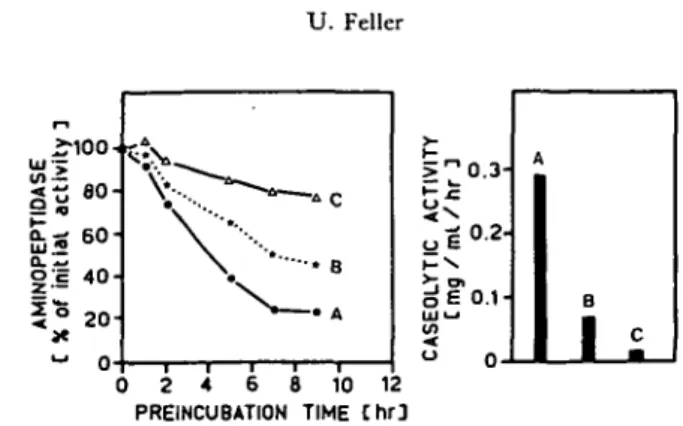In Vitro Stability and Inactivation of Peptide Hydrolases
Extracted from Phaseolus vulgaris L.
Urs Feller
PJlanzenphysiologisches Instiltit, Universitdt Bern, AUenbergrain 21, CH-3013 Bern, Switzerland
Endopeptidase activity against azocasein had a higher temperature optimum (50°C) in leaf extracts than in cotyledon extracts (37°C). The temperature optima for aminopeptidase (46°C) and for carboxypeptidase (53°C) were similar in leaf and cotyle-don extracts. The endopeptidase activity showed an excellent stability in crude extracts from leaves even at 37°C, while the endopeptidase in cotyledon extracts was less stable. Carboxypeptidase was very stable in both leaf and cotyledon extracts. Aminopeptidase was the least stable of the enzymes investigated and its inactivation rate depended on the source of the extract. A moderate stability was observed in extracts of leaves or of ungerminated seeds, but this enzyme was rapidly inactivated in cotyledon extracts at pH 5.4. At pH 7.5 aminopeptidase remained active longer than at pH 5.4. From experiments with mixed extracts it could be concluded that in cotyledons an amino-peptidase inactivating factor was formed during germination. This factor was heat sensitive, excluded by Sephadex G-25, precipitated by 75% ammonium sulfate and inhibited by tosyl-L-lysine chloromethyl ketone. These data suggest that the factor is a protein and considering the similar properties it appears possible that it is the endo-peptidase formed during germination.
Key words: Aminopeptidase inactivation — Endopeptidase — Peptide hydrolase —
Phaseolus vulgaris — Stability (peptide hydrolase).
High peptide hydrolase activities are necessary for the rapid protein mobilization during germination and during leaf senescence. In cotyledons of germinating mung beans (Chrispeels and Boulter 1975) or of bush beans (Feller 1979) and in corn endosperms (Feller et al. 1978) endopeptidase and carboxypeptidase showed maximal activities during protein mobilization, while aminopeptidase activity was high in dry seeds and decreased during germination. Peptide hydrolase activities present in mature rye seeds remained high during storage for several years at room temperature and only minor activity losses were observed (Nowak and Mierzwinska 1978). Aminopeptidase activity which is stable for years in dry seeds, can be inactivated in bean cotyledons or in endosperms of cereals within a few days during germination. Hayden and Hopkins (1980) found that the thermal stability of aminopeptidase was different in scutellum and endosperm extracts of germinating corn seeds. Further they found large differences between scutellum extracts of various genotypes and it was unlikely that the observed differences were due to Abbreviations: TLCK, Na-/>-tosyl-L-Iysine chloromethyl ketone; CAS. ACT., Caseolytic activity.
varying proportions of isoenzymes. Aminopeptidase activity decreased during protein mobilization in senescing leaves (Thomas 1978, Feller and Erismann 1978, Waters et al. 1980) suggesting no major role for this enzyme during protein mobili-zation. The physiological function of aminopeptidase is still unresolved.
Inactivation by proteolysis was described for a series of enzymes in yeast (Neeff et al. 1978, Matern and Holzer 1979) and possible regulation mechanisms for the enzyme inactivation by peptide hydrolases have been reviewed by Holzer and Heinrich (1980). A nitrate reductase inactivating enzyme has been found in corn roots (Wallace 1973, 1974). This enzyme was identified as a peptide hydrolase being active against other substrate proteins (Wallace 1978, Shannon and Wallace 1979). Another plant enzyme, ribulose bisphosphate carboxylase was also shown to be a good substrate for endogenous peptide hydrolases (Peoples and Dalling 1978, Wittenbach et al. 1980, Thomas and Huffaker 1981).
The objectives of this work were to investigate the stability of bean peptide hydrolases in vitro and to study the effect of different incubation conditions on their inactivation. In this context it would be interesting to know whether the stability of endo- and exopeptidases is affected by other endogenous peptide hydrolases.
Materials and Methods
Plant materials—Phaseolus vulgaris L. (cv. "Saxa", Stamm Vatter) were used lor
all experiments. The dry seeds were soaked in tap water at 37°C for 8 hr and then germinated at 24:jr2°C on wet paper towels in the dark (time of soaking=day 0).
For cotyledon samples the seedlings were kept in the dark on wet paper until harvest-ing. For leaf samples seedlings were transferred to coarse quartz sand on day 4, irrigated with tap water and incubated in a light/dark cycle of 14/10 hr. The cotyledon and leaf samples were stored at — 20°C before extraction.
Enzyme extraction and preincubation of the extracts—Leaf samples were extracted in
five volumes of cooled extraction medium (50 n w acetate buffer pH 5.4 containing 1% Polyclar AT and 0 . 1 % mercaptoethanol). For cotyledon samples 20 ml medium were taken to extract 6 cotyledon pairs. A Polytron homogenizer (Kine-matica, Luzern) was used for the extraction first at low speed for about 20 sec and then at full speed for 5 sec. The homogenate was passed through Miracloth (Calbiochem, San Diego), centrifuged for 10 min at 2,300 X^ in a refrigerated bench centrifuge and the supernatant was used as the enzyme source (crude extract). For the investigation of enzyme stabilities the crude extracts were preincubated in stoppered tubes in the refrigerator (2°C) or in water bathes (18, 30 or 37°C).
Enzyme assays—The crude extracts were used for the aminopeptidase assay (rate
of hydrolysis of L-leucine-/>-nitroanilide at p H 7.0) without desalting. For carboxy-peptidase (rate of hydrolysis of iV-CBZ-L-phenylalanine-L-alanine at pH 5.0) and for endopeptidase measurements (rate of hydrolysis of azocasein) the crude extracts were desalted through a Sephadex G-25 column as reported previously (Feller et al.
1977). Except for the temperature optima measurements all enzyme assays were carried out at 37°C using the procedures already described (Feller and Erismann 1978). For the measurements of the azocasein hydrolysis at p H 5.4 a 50 mM acetate buffer containing 0 . 1 % mercaptoethanol (added immediately before use) replaced the Tris/HCl buffer p H 7.5 and the tubes were closed during incubation. When
necessary the q u a n t i t y of extract was modified for the a m i n o - and carboxypeptidase assays to allow measurements in the optimal range.
D u r i n g d e t e r m i n a t i o n of the t e m p e r a t u r e o p t i m a the stoppered tubes were incubated in a n a l u m i n i u m block with holes for the tubes, which was cooled on one side a n d heated on the other giving a t e m p e r a t u r e gradient from 18 to 90°C. For 2°C t h e tubes were placed in the ice b a t h . T h e a c t u a l t e m p e r a t u r e was d e t e r m i n e d d u r i n g incubation. U n d e r these conditions carboxypeptidase was incubated for 120 m i n instead of 30 m i n used in the s t a n d a r d assay p r o c e d u r e (Feller and E r i s m a n n 1978).
Results
The inactivation of exo- and endopeptidases in crude extracts of bean leaves
Table 1 Stability of peptide hydrolases in crude extracts from beans preincubated at 2°C and at
37°C Enzyme source Cotyledons Leaves Cotyledons Leaves Cotyledons Leaves Cotyledons Leaves p H 5.4 7.5 5.4 7.5 5.4 7.5 5.4 7.5 5.4 7.5 5.4 7.5 5.4 7.5 5.4 7.5 Initial activity" 1. 74±0. 18 2.68±0. 19 0.27+0.04 0.42 ±0.05 18.9 ±1.7 21.3 ±1.2 4.65 ±0.13 5. 35 ±0.62 0.45±0. 04 0.43 ±0.04 0. 12 ±0.02 0. 10±0. 02 0. 19+0.02 0.27+0.01 0.25±0.01 0.25+0.01 8 hr 24 hr 46 90 80 94 103 97 93 73 107 94 126 138 118 121 110 118
% of the initial activity * 2°C 48 hr 96 hr Aminopeptidase 43 36 29 63 49 36 69 87 69 70 Carboxypepti 92 106 97 96 96 68 Azocasein 100 83 94 126 Azocasein 151 113 114 124 120 75 65 61 dase 101 84 107 57 hydrolysis at p H 5.4 104 96 74 47 117 147 hydrolysis 152 120 128 127 110 116 at p H 7.5 155 75 120 93 3 hr 9 74 40 65 120 73 126 90 94 44 96 97 154 73 129 134 37°C 8 h r 8 39 25 49 106 69 77 63 59 23 60 88 77 23 93 101 24 hr 8 7 14 34 77 57 66 59 cs o C O ( M 53 69 47 20 91 80 Cotyledons of seeds germinated for 5 days and primary leaves of 14 day old plants were extracted in acetate buffer (pH 5.4) or in Tris/HCl buffer (pH 7.5). Extraction and determination of enzyme activities were carried out under standard conditions as described in Materials and Methods. " Mean and standard deviation of 4 measurements are expressed for the initial activity in /imol/hr/ml (aminopeptidase, carboxypeptidase) or in mg/hr/ml (azocasein hydrolysis).
and cotyledons is shown in Table 1. Aminopeptidase was in general the least stable of the four enzyme activities investigated. At pH 7.5 this enzyme remained active longer than at pH 5.4. Aminopeptidase was inactivated more rapidly in extracts from cotyledons of germinating seeds than in leaf extracts. The differences between leaf and cotyledon extracts could be due to the presence of different amino-peptidase activities or to the presence of undetermined effectors in the crude extracts. Carboxypeptidase was more stable than aminopeptidase and remained active longer at pH 5.4 than at pH 7.5. The inactivation in cotyledon extracts was comparable with that observed in leaf extracts.
The endopeptidase activity (azocasein hydrolysis) was measured at pH 5.4 and at pH 7.5. At 2°C only minor activity losses were observed during 96 hr and often the activity increased slightly during preincubation. This increase was also observed in other experiments and could be due to the disappearence of substrates competitive with azocasein or of inhibitors present in the crude extracts. At 37°C the endo-peptidase activities from cotyledons decreased faster than those from leaves. In cotyledon extracts the decrease of endopeptidase activities was slower at pH 5.4 than at pH 7.5.
The temperature optima for the different peptide hydrolases are shown in Fig. 1. Aminopeptidase had its temperature optimum around 46°C and 50% of the maximal activity were observed at 55°C, while carboxypeptidase showed maxim-al activity around 53°C and increasing the temperature to 66°C its activity was reduced to 50%. No major differences in the temperature optima for the exo-peptidases were observed comparing leaf and cotyledon extracts. The temperature optimum of the endopeptidase activities was considerably lower for cotyledon extracts (around 37°C) than for leaf extracts (around 50°C).
The germination time affected the aminopeptidase stability in extracts of
cotyle- 00- 80- 60- 40- 20- 00- 80- 60- 40- 20-A A 0 A A • •
c
A * 20 / VA A y^ • A • " • A * • • A AV ' "* / . * • A * ' . A 4 0 60 INCUBATION • -• • -B a . • ' * D ocP a 80 0 20 TEMPERATURE C " a a a a T T to * 40 60 C 1 a a'•S
" » SB ' 80Fig. 1 Effect of incubation temperature on exo- and endopeptidase activities extracted from bush
beans. A and B: extract from leaves (primary leaves and first trifoliate of 20 day old plants). C and D: extracts from cotyledons (of dry seeds for aminopeptidase and of seeds germinated for 6 days for the other enzyme activities). The symbols represent individual measurements. Aminopeptidase (•), carboxypeptidase (A) and caseolytic activities ( T ) , at pH 5.4; • , at pH 7.5) were assayed as described in Materials and Methods.
GERMINATION TIME: • — • 1day A—4 2 days .--•• 4 days o—o e days 8 days 5 10 15 2 0 25 PREINCUBATION TIME thr] 1 day 8 days o—o 1 day+8 days
» 1 day+ 8 days calculated
5 10 15 20 25 PREINCUBATION TIME [hr]
Fig. 2 Aminopeptidase stability in crude extracts from bean cotyledons. Extracts in acetate buffer pH 5.4 containing 0.1% mercaptoethanol were preincubated at 2°C and the remaining activity was measured at different preincubation times. The values for the initial activity (0 hr) represent the average of 2 determinations and the other points represent individual measurements. Extracts were prepared from cotyledons of seeds germinated for 1, 2, 4, 6 or 8 days (A). The aminopeptidase stability in mixed extracts (1 day+8 days) was compared with the theoretical curve calculated from the time courses of the unmixed extracts (B).
dons (Fig. 2A). The activity decreased more quickly if seeds were germinated for a few days. After germination for 6 or 8 days extractable aminopeptidase activity decreased during the first 2 hr and then remained stable at a low level. There was always some aminopeptidase activity remaining after incubation at 2°C, which disappeared at higher preincubation temperatures. It remains open, whether this remaining activity was due to the presence of isoenzymes or to effects of other enzymes in the extract.
The question arose whether the faster inactivation of aminopeptidase in vitro with increasing germination time was due to changes in the aminopeptidase (modifi-cation of the enzyme protein during germination), to the disappearance of a stabi-lizing factor or to the formation of an inactivating factor. In mixed extracts (Fig. 2B) aminopeptidase was inactivated faster than predicted assuming the same stability as in the unmixed extracts. These results suggest the presence of an aminopeptidase inactivating factor in the cotyledon extract of seeds germinated for 8 days. In further experiments it was observed that this factor was excluded by Sephadex G-25 and was precipitated by 75% ammonium sulfate (data not shown).
In extracts of ungerminated seeds aminopeptidase was fairly stable even at pH 5.4 after incubation for several hours at 30°C (Table 2). If the extract of the ungerminated seeds was mixed with extract of cotyledons harvested after germination for 6 days, then aminopeptidase became more labile and at pH 5.4 the inactivation was faster at higher preincubation temperatures. These results confirm the presence of a factor inactivating aminopeptidase in cotyledon extracts of germinated seeds. In mixed extracts incubated at pH 7.5 no major decreases in aminopeptidase activity could be observed at all 3 preincubation temperatures indicating a more rapid inactivation of aminopeptidase by this factor in the acidic pH-range. The last values (24 hr) of the 30°C incubations of extract from ungerminated seeds were extremely low at both pH-values and a precipitate was formed in the crude extract and therefore these values should be interpreted with precaution.
Table 2 Effect of temperature on aminopeptidase stability in Pretreatment P H 5.4 7.5 5.4 7.5 Temperature (°C) 2 18 30 2 18 30 2 18 30 2 18 30 Ohr 8.75 8.87 8.72 7.98 7.96 7.96 1 hr 2 hr Cotyledons 0 7.64 7.62 7.55 7. 11 7.28 7.30 Cotyledons 0 < 5.55 5.50 5.39 4.78 4.67 4.48 3.84 3.60 2.22 4.47 4.54 4.75 7.32 7.21 7.00 6.79 6.97 6.88 i crude extracts /imol/hr/ml 3 h r days 7.37 7.11 6.87 6.96 6.92 6.94 days4-cotyledons 2.90 2.60 1. 18 4.46 4.47 4.44 2.33 2.06 0.70 4.80 4.83 4.65 5 h r 7.01 6.96 6.09 6.77 6.88 6.81 6 days 1.52 1.30 0.36 4.55 4.73 4.85 7 h r 6.86 7.36 4.78 7.29 7.70 7.96 1.05 0.86 0.30 3.94 4.12 4.82 9 h r 6.84 7.06 3.78 7.56 7.77 8.17 1.00 0.72 0.25 3.96 4.26 4.38 24 hr 3.31 3.97 1.00 7.00 7.62 1.67 0.84 0.42 0.16 3.41 3.89 4.37 Extract from cotyledons of ungerminated seeds (cotyledons 0 days) or mixed extracts (1 : 1) from cotyledons of ungerminated and of 6 day germinated seeds (cotyledons 0 days 4-cotyledon 6 days) were preincubated at 2, 18 and 30°C. The remaining aminopeptidase activity was determined after various preincubation times under standard conditions as described in Materials and Methods. The data shown represent individual measurements.
After germination for 2 days the stability of aminopeptidase in the extract (Fig. 3A) and the extractable aminopeptidase activity (Fig. 3B) decreased, while the extractable endopeptidase activity at pH 5.4 increased at the same time. The increase in carboxypeptidase occurred about one day later. Since the results in Fig. 3A and 3B were obtained from the same extracts a direct comparison is possible. The decrease in aminopeptidase stability in vitro and the increase in extractable endopeptidase activity occured simultaneously and evidence for or against the hypothesis that endopeptidase could be the factor would be desirable.
The heat stability (Fig. 4) and the response to TLCK (Fig. 5) were used to compare the properties of the aminopeptidase inactivating factor with those of the endopeptidase. If the extract of germinated seeds was heated for 1 hr above 53°C, then the endopeptidase was inactivated (Fig. 4A) and the stability of aminopeptidase added after cooling in iced water was improved (Fig. 4B). After adding the amino-peptidase activity (extract of ungerminated seeds) all tubes were kept under the same conditions (2°C, pH 5.4), therefore the observed differences must be due to different levels of the aminopeptidase inactivating factor present in extracts of cotyledons from germinated seeds. Carboxypeptidase showed a different response to the heat treatment and was inactivated only to about 50% by the preincubation at 53°C for 1 hr. In the heat inactivation experiment the aminopeptidase inactivating factor and the endopeptidase activity behaved similarly, but carboxypeptidase was more stable. Aminopeptidase and carboxypeptidase were not affected by TLCK
AMINOPEPTIOASE 100 5 SO z 40 | 20 UJ °= 0 ^ ^ .—.CARBOXYPEPTIDASE \ A — A CAS. ACT. pH 5.4 £0.5-<PO. " 0 l o B °CARBOXYPEPTIDASE ^AMINOPEPTIDASE -•CAS. ACT. pH 5.4 0 1 2 3 4 5 6 GERMINATION TIME Cdays]
Fig. 3
"I
1 0 " = 60 4 0 -~ 0 B — 2hr —t15hr —a25hr * „*—•—* •/ A/is*
0 5 45 50 55 60 65 70 75 PREINCUBATION TEMPERATURE C °C ] Fig. 4Fig. 3 Changes in the aminopeptidase stability (A) and in the pattern of peptide hydrolase activities (B) in crude extracts from cotyledons during germination. Extracts of seeds germinated for 0 to 9 days were assayed immediately after extraction for the peptide hydrolase activities. After pre-incubation at 2°C for 1, 3, 8 and 22 hr the remaining aminopeptidase activity was measured under standard conditions and expressed in % of the initial activity (0 hr). Each point represents the average of 2 measurements.
Fig. 4 Partial heat inactivation of extracts from cotyledons of seeds germinated for 6 days (A) and stability of subsequently added aminopeptidase extracted from ungerminated bean seeds (B). Cotyledon extracts from germinated seeds were preincubated for 1 hr at various temperatures, cooled in iced water, mixed 1 : 1 with fresh extract from ungerminated seeds (aminopeptidase source) and then kept at 2°C (pH 5.4). The remaining carboxy- and endopeptidase activities were analyzed immediately after mixing the 2 extracts. Aminopeptidase activity determined 0, 2, 15 and 25 hr after mixing is expressed in % of the initial activity. All enzymes were assayed as described in Ma-terials and Methods and the symbols represent the average of 2 determinations.
in the assay mixture (data not shown), while endopeptidase activity was reduced to about 30% by the addition of 3 mM TLCK to the extract. If TLCK was added in a final concentration of 3 mM to a mixture of cotyledon extracts of germinated and ungerminated seeds, then aminopeptidase inactivation was slower than in the appropriate control without TLCK (Fig. 5).
Discussion
The endopeptidase(s) extracted from bean leaves remained active for a long time in vitro and showed a rather high temperature optimum (50°C). The
endo-_
0 2 4 6 8 10 12 PREINCUBATION TIME Chr]
Fig. 5 Effect of tosyl-L-lysine chloromethyl ketone (TLCK) on aminopeptidase stability and on endopeptidase activity. Untreated extract from ungerminated seeds was mixed with extracts from cotyledons of seeds germinated for 9 days. The extract of the germinated seeds was untreated (A). with a final concentration of 3 miu TLCK after mixing (B) or boiled for 10 min (C). The points and columns represent the averages of 3 determinations.
peptidase activity in cotyledon extracts was less stable and had a lower temperature optimum (37°C). Different properties of the endopeptidase activities in extracts of leaves and cotyledons in respect to pH-optima and to mercaptoethanol effects have been reported earlier (Feller 1979) and are consistent with the observed differences in the temperature optima and in the in vitro stabilities.
Carboxypeptidase showed a high temperature optimum and was in comparison with the other enzymes investigated quite stable in vitro. For carboxypeptidase no major differences were observed between leaf and cotyledon extracts.
The temperature optimum for aminopeptidase was similar for leaf and cotyledon extracts, but the stability was dependent on the enzyme source. While this enzyme was relatively stable in extracts from bean leaves or from ungerminated seeds, an accelerated inactivation was observed in cotyledon extracts of germinated seeds. From the results obtained with mixtures of extracts from germinated and ungermi-nated seeds it can be concluded that something in the extract of germiungermi-nated seeds was reducing aminopeptidase stability. This factor increased during germination, was heat labile, excluded by Sephadex G-25 and precipitated by 75% ammonium sulfate. From this data it appears reasonable that the aminopeptidase inactivating factor was a protein and that the inactivation was an enzymatic process. This factor showed a heat stability similar to the endopeptidase activity, increasing in cotyledons during germination. The factor was partially inhibited by TLCK, an inhibitor of some endopeptidases, while TLCK did not stabilize aminopeptidase in extracts of ungerminated seeds. These data suggest that aminopeptidase was inactivated in the acidic pH-range by another peptide hydrolase (endopeptidase). The inactivation of plant enzymes by endogenous peptide hydrolases may be important in vivo and in vitro. In addition to the subcellular distribution of the peptide hydrolases (Heck et al. 1981), the susceptibility of the different enzymes to endogenous peptide hydrolases could be a further factor causing different breakdown rates in vivo. Changing patterns of peptide hydrolase activities can alter enzyme stability in extracts and this proteolysis in vitro must be taken into account when investigating plant enzymes.
I thank Prof. Dr. H. Holzer (University of Freiburg i. Br., FRG) for encouraging discussions and for a sample of TLCK. Mr. H. Lauffer for designing and constructing the aluminium block for the temperature gradients, Mr. W. Fuhrer for performing preliminary experiments and Dr. M. Ernes for his assistance in preparing the manuscript. The work was supported by Swiss National Science Foundation (Project 3.259-0.77).
References
Chrispeels, M. J. and D. Boulter (1975) Control of storage protein metabolism in the cotyledons of germinating mung beans: role of endopeptidase. Plant Physiol. 55: 1031—1037.
Feller, U. K., T.-S. T. Soong and R. H. Hageman (1977) Leaf proteolytic activities and senescence during grain development of field-grown corn (Zea mays L.). Plant Physiol. 59: 290-294. Feller, U. K., T.-S. T. Soong and R. H. Hageman (1978) Patterns of proteolytic enzyme activities
in different tissues of germinating corn (Zea mays L.). Planta 140: 155-162.
Feller, U. and K. H. Erismann (1978) Veranderungen des Gaswechsels und der Aktivitaten proteo-lytischer Enzyme wahrend der Seneszenz von Weizenblattern (Triticum aestivum L.). Z.
Pflanzen-physiol. 90:235-244.
Feller, U. (1979) Nitrogen mobilization and proteolytic activities in germinating and maturing bush beans (Phaseolus mdgaris L.). Z. Pflanzenphysiol. 95: 413-422.
Hayden, D. B. and W. G. Hopkins (1980) Tissue specific variations in the thermal stability of maize aminopeptidases. Z. Pflanzenphysiol. 99: 367-371.
Heck, U., E. Martinoia and Ph. Matile (1981) Subcellular localization of acid proteinase in barley mesophyll protoplasts. Planta 151: 198-200.
Holzer, H. and P. C. Heinrich (1980) Control of proteolysis. Ann. Rev. Biochem. 49: 63-91. Matern, H. and H. Holzer (1979) Endogenous proteolytic modulation of yeast enzymes. In
ICN-UCLA Symposia on Molecular and Cellular Biology. Edited by D. E. Atkinson and C. F. Fox. p. 81-92. Academic Press, New York.
Neeff, J., E. Hagele, J. Nauhaus, U. Heer and D. Mecke (1978) Evidence for catabolyte degradation in the glucose-dependent inactivation of yeast cytoplasmic malate dehydrogenase. Eur. J. Biochem. 87: 489-495.
Nowak, J. and T. Mierzwinska (1978) Activity of proteolytic enzymes in rye seeds of different ages. Z. Pflanzenphysiol. 86: 15-22.
Peoples, M. B. and M. J. Dalling (1978) Degradation of ribulose-l,5-bisphosphate carboxylase by proteolytic enzymes from crude extracts of wheat leaves. Planta 138: 153-160.
Shannon, J . D. and W. Wallace (1979) Isolation and characterization of peptide hydrolases from the maize root. Eur. J. Biochem. 102: 399-408.
Thomas, H. (1978) Enzymes of nitrogen mobilization in detached leaves of Lolium temulentum during senescence. Planta 142: 161-169.
Thomas, H. and R. C. Huffaker (1981) Hydrolysis of radioactively-labelled ribulose-l,5-bisphos-phate carboxylase by an endopeptidase from the primary leaf of barley seedlings. Plant Sci. Lett. 20: 251-262.
Wallace, W. (1973) A nitrate reductase inactivating enzyme from the maize root. Plant Physiol. 52: 197-201.
Wallace, W. (1974) Purification and properties of a nitrate reductase-inactivating enzyme. Biochim.
Biophys. Ada 341: 265-276.
Wallace, W. (1978) Comparison of a nitrate reductase-inactivating enzyme from the maize root with a protease from yeast which inactivates tryptophan synthase. Biochim. Biophys. Ada 524: 418-427.
Waters, S. P., M. B. Peoples, R . J . Simpson and M. J. Dalling (1980) Nitrogen redistribution during grain growth in wheat (Triticum aestivum L.) I. Peptide hydrolase activity and protein breakdown in the flag leaf, glumes and stem. Planta 148: 422-428.
Wittenbach, V. A., R. C. Ackerson, R. T. Giaquinta and R. R. Hebert (1980) Changes in photo-synthesis, ribulose bisphosphate carboxylase, proteolytic activity, and ultrastructure of soybean leaves during senescence. Crop Sci. 20: 225-231.
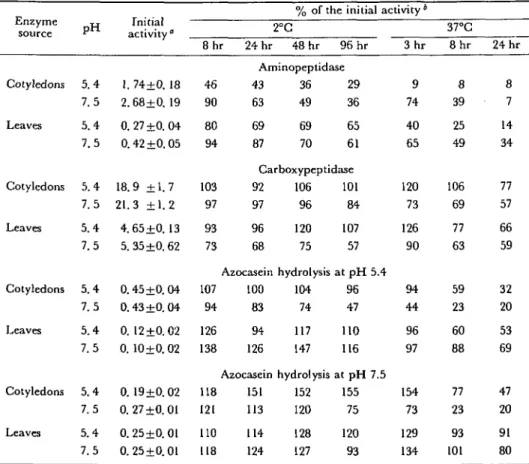
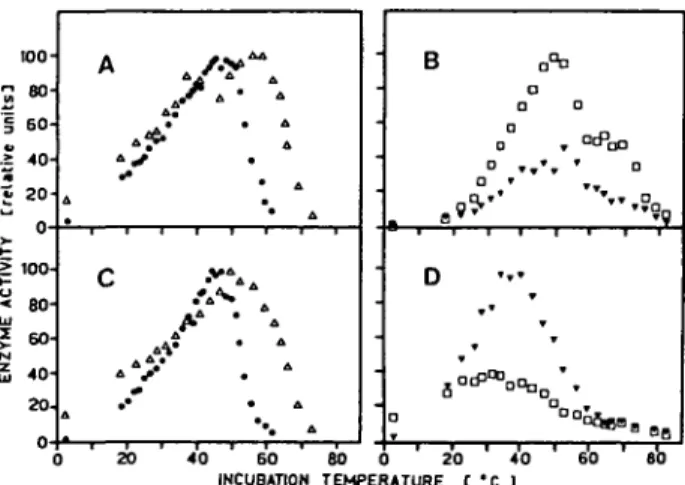
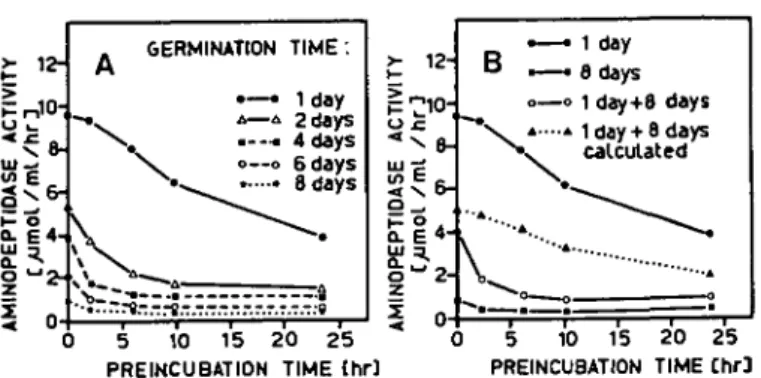
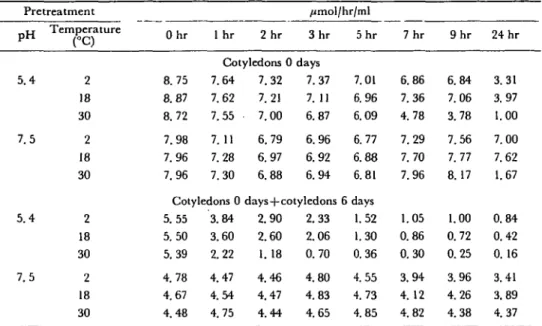
![Fig. 3 "I1 0 " = 60 4 0 -~ 0 B — 2hr—t15hr —a25hr / * „*—•—* •A/is* 0 5 45 50 55 60 65 70 75PREINCUBATION TEMPERATURE C °C ]Fig](https://thumb-eu.123doks.com/thumbv2/123doknet/14894820.650956/7.893.181.714.160.547/fig-i-b-hr-hr-preincubation-temperature-fig.webp)
